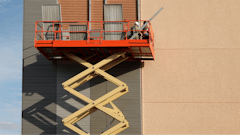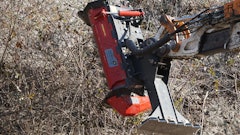The increasing popularity of tool carriers in the construction market has been spawned by the vast number of attachments contractors can choose to complete almost any task. With just one attachment, contractors have discovered they can use it across several different carriers, such as skid-steer, compact track and all-wheel-steer loaders, compact excavators, utility work machines and backhoe-loaders.
"Rental businesses don't want to buy an attachment for every single tool carrier; they like an attachment to work over several different carriers, which has made compact equipment popular in the construction industry," says Rae Dell Braaten, attachment product manager for Bobcat Company.
Because of attachments like hydraulic breakers, sweepers, trenchers, augers and combination buckets, tool carriers are making their mark on construction sites. And in order to maintain the optimal versatility of their tool carriers, rental businesses are realizing they must maintain their attachments regularly.
While tool carriers have basic components that should be inspected and maintained when running both hydraulic and non-hydraulic attachments, each of the dozens of attachments available also has parts that must be serviced on a regular basis.
Hydraulic breaker
The hydraulic breaker is an attachment that is commonly used for performing concrete demolition. Because of the enormous force and vibration hydraulic breakers both produce and sustain, Braaten says special attention should be paid to the connection points between the attachment and the tool carrier.
The actual tool point on hydraulic breakers should also be inspected for wear. Operators can equip hydraulic breakers with several different tool points, such as the crosscut chisel, nail point and tamping pad, which all wear differently. Be cautious to avoid wearing down your tool point so much that the nose of the hydraulic breaker, rather than the tool, comes in contact with the material. "You want your tool point long enough so that you can punch through the material without hitting the nose," Braaten says.
In addition to the tool point, operators should ensure the hydraulic hoses are routed properly through the pivot point and out of harm's way; the tool bushing that fits around the tool isn't loose; the tool is greased; and the nitrogen charge pressure is at the right level. "If you have a weak charge, you're going to have a breaker that's hitting just as fast, but it won't be hitting hard enough to get the work done," Braaten says.
Proper operating techniques are critical to preventing wear on hydraulic breakers. In colder climates, instruct operators to run the breaker slowly in the beginning, allowing it time to rise to its operating temperature. Prying is also not advised. "You want to break the material away so that it breaks in pieces, and you can kind of push them away from you without prying them loose," Braaten says.
Sweeper
Having a sweeper attachment can be a valuable tool on the jobsite for keeping the work area clean. More and more cities are enforcing strict guidelines that require contractors to keep streets and sidewalks dirt-free, especially in residential areas. So instead of using manual labor and hand brooms to sweep the jobsite, a sweeper attachment can clean a small or large area with less effort and in less time.
Keeping the attachment connection points clean is extremely important when operating the sweeper because contamination can damage the motor, resulting in insufficient power to drive the sweeper broom.
Inspecting the bristles daily for wear is another critical maintenance practice. One of the most prevalent ways operators misuse the sweeper attachment is by applying too much down pressure on the bristles, Braaten says. "Operators think the harder they press the bristles down, the better it will sweep," he says. "If you're in a machine, you don't realize the strength that the carrier can hydraulically place on those bristles. If you reduce the amount of down pressure on the bristles, they'll sweep better."
Braaten gives these three tips for contractors operating sweeper attachments:
- Keep a good cutting edge. "If you don't have to put pressure against your cutting edge to sweep, then don't. You should only have to apply cutting-edge pressure when you have dried mud on a surface that you need to scrape off," he says.
- Don't put too much down pressure on the bristles.
- Adjust the bristle contact area as the bristles wear. "As the bristles wear, you'll get a bigger and bigger gap between the bristles and the cutting edge. Most sweeper buckets have adjustment bolts on the side," he says.
Combination bucket
The combination bucket is popular in the construction industry because it's really four buckets in one. It can be used for dozing, grappling, leveling, digging, loading and dumping. Because of its versatility, the combination bucket has several additional parts such as quick couplers, hoses and pivot points, which are not found on general-purpose buckets.
To properly maintain the combination bucket, Braaten says the pivot points must be greased and the bushings and pins replaced. In addition to looking for any cylinder leaks, the cutting edges, teeth and hoses on the bucket should be inspected daily. Special attention should be paid to the hoses because if they are not routed properly and if their protective covering is not in place, then it increases the risk of damage.
The pivot points should be inspected seasonally for wear and to see if new bushings or pins are needed. "If you have a worn pivot point, it's going to interfere and the bucket is not going to close properly, causing material to slip out when using it as a bucket," Braaten says.
The structural integrity of a combination bucket can be preserved by instructing customers to avoid a simple operation practice - corner loading. "If you're going to try and root out a stump with a combination bucket, do it in the center," Braaten says. "Put it in the center of your dozer blade and clamp down on it." Excessive corner loading can cause hydraulic lines, cylinders and the bucket's jaws to fail.
Auger
Of all the attachments available for tool carriers, the auger attachment is one that spans more carriers than any other when it comes to hydraulic flow characteristics. Even so, it's important to make sure you have the right drive carrier for the flow of the auger, which is used to drill holes for fence posts, piers, poles and trees. The carrier's rated operating capacity and horsepower should also properly match the size of the auger.
"Augers will work on anything from backhoe-loaders to compact excavators to compact track loaders, but probably the very best machine to use an auger is a vertical lift skid-steer or compact track loader," Braaten says. With a radius lift path machine, operators might have to back up slightly as they pull the bit out of the hole because the natural geometry of the boom will pull the auger away from them. A vertical lift path machine, however, will pull the auger out straight.
Attaching an auger can be difficult because it goes through several ranges of motion, from digging holes to pulling out dirt and putting it back. Because of this, it is critical that the auger attachment hoses are routed properly and that the mechanical fasteners are engaged on the attachment.
In maintaining the auger, inspect the replaceable teeth for wear, especially the outside teeth that are used to cut a clean edge to the hole. You should also ensure the output shafts aren't marred, because if they are, the attachment bits won't telescope over the shaft, Braaten says.
Depending on the ground conditions, the auger speed and down pressure should be adjusted to obtain the best productivity. For example, a higher rpm is needed when operating in sand because less down pressure is necessary to drill the hole. But operating the attachment in shell or rock will require a slow rpm and strong down pressure in order to give the bit time to carve out the material. "You don't want to spend the bit too fast because all it will do is glaze the rocky surface and never fully engage or bite," Braaten says.
Trencher
The trencher, which can be used to install irrigation, cable, phone and other utilities, is another frequently used attachment on construction sites. On this attachment, the trencher teeth are the major wear items that should be inspected regularly. One way to prevent the teeth from wearing prematurely is to equip the attachment with teeth that are appropriate for the digging conditions. The trencher chain rollers and the trencher boom sprocket also wear because they are both ground engaging.
Be observant of the trencher chain tension. If a trencher chain looks too loose or sloppy, it's often a sign that it needs to be adjusted. However, adjusting the chain so that it fits too tightly can also pose both maintenance and performance problems. Braaten says it's a common mistake to make the chain too tight, thinking it will prevent the chain from rolling off in the trench. "But when you do that, it induces wear on both the chain sprocket and wheel, and it robs you of performance," he says.
The spoil auger that pushes the material away from the trench is another important item for maintenance and inspection. The trencher's spoil auger is made adjustable because most trencher attachments can be set to trench as narrow as 4 inches or as wide as 18 inches. So in order for the spoil auger to push the dirt away from the trencher, it must be set according to the width of the trench.
While these are five attachments that can typically be found in rental inventories, there are many more that can make your customers' jobs easier. And just as attachments and tool carriers go hand-in-hand, so does maintenance and versatility - because without proper maintenance, attachments will cease to provide versatility to your compact equipment fleet.


























